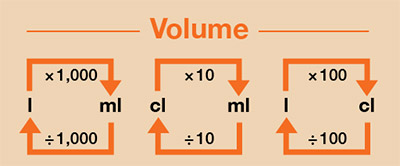As you probably already know, when you are talking about volume unit conversions, you need to remember that there are three different measuring systems: the US Customary System, the British Imperial System, and the metric (SI) units of volume. So, which one should you choose?

According to a lot of people, the metric system tends to be the best measurement system. But why?
Some Of The Reasons Why The Metric System Is Better:
- The US Customary System uses two different definitions in what concerns both the quart and the pint. The main difference is made in terms of dry and wet. Well, while they have a different size, the truth is that most Americans has some difficulty understanding it.
- The US Customary System has the ounce that refers to a fluid volume. However, the same ounce can also refer to mass. As you can imagine, these are not interchangeable. So, an ounce of liquid doesn’t weigh an ounce.
- If you think about the British Imperial Measurement System for a while in terms of liquid and dry measures, you can only use the ounce, pint, and quart. However, these are different from the US measures as well as from the British Imperial gallon, peck, and bushel.
Learn how to convert 8 oz to ml.
Understanding The Most Common Volume Unit Conversions

#1: Ounce (oz):
1 fluid ounce = 1/8 of a half-pint
1 fluid ounce = 1/16 of a pint
1 fluid ounce = 1/32 of a quart
1 fluid ounce= 1/128 of a gallon
1 fluid ounce = 29.5735 milliliters
Immediately know how many ml are in 8 oz.
#2: Pint (pt):
Two half-pints = 16 ounces in a pint
2 pints = 1 Quarter
8 pints = 1 gallon
1 pint = 473.176 milliliters
#3: Quart (qt):
4 half-pints = 2 pints
4 half-pints = 32 ounces in a quart
4 quarts = 1 gallon
1 quart = 0.94635 liters
1 quart = 946.35 milliliters
#4: Gallon (gal):

1 gallon = 231 cubic inches
1 gallon = 128 ounces
1 gallon = 8 pints
1 gallon = 4 quarts
1 gallon = 3.785 liters
Discover everything you need to know about converting oz to ml.
#5: Milliliter (ml):
The prefix “milli” means 1/1000, so:
1 milliliter = 0.001 liters
1000 milliliters = 1 liter
1 milliliter = 0.0338 fluid ounces
The milliliter is also known as a cubic centimeter because a cube 1 cm on each side has a volume of 1 ml. Because water has a density of 1.0, one ml of water weighs 1 gram.
#6: Liter (l):
1 liter is the volume of a cube that is 10 cm (1 decimeter) on each side.
1 liter = 10 deciliters
1 liter = 1,000 milliliters
1 liter = 1,000 cubic centimeters
1 liter = 1.057 quarts
1 liter = 33.814 ounces
Because water has a density of 1.0, one liter of water weighs 1,000 grams = 1 kilogram.
#7: Cubic Inches (in3):
This is the volume occupied by a cube one inch on a side.
1 cubic inch = 16.387 cubic centimeters (cc and mL)
1728 cubic inches = 1 cubic foot
231 cubic inches = 1 gallon
#8: Cubic Feet (ft3):
This is the volume occupied by a cube one foot on a side.
1 cubic foot = 1728 cubic inches
1 cubic foot = 28,316.8 cubic centimeters